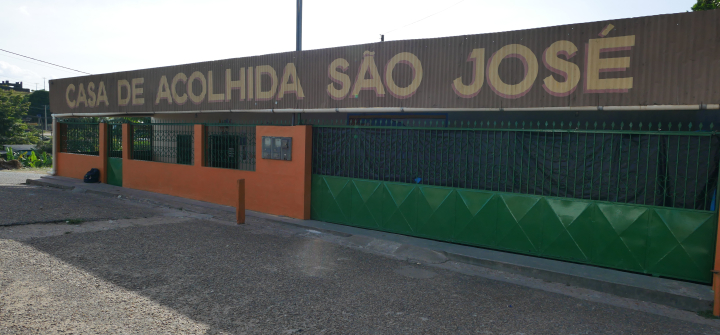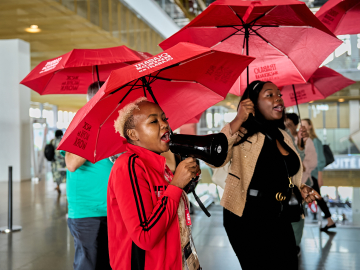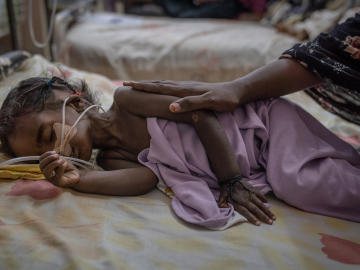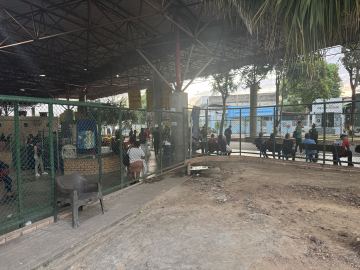The Women Protecting Migrants in Brazil’s North
BOA VISTA, Brazil—From Pacaraima on the border with Venezuela, to the Roraima state capital of Boa Vista, and all the way to Bonfim on Brazil’s frontier with Guyana, traffickers prey on vulnerable migrants trying to survive.
They entice the vulnerable with promises of good jobs and high salaries—only to ensnare them in sex work and forced labor with meager or even no pay.
Often the migrants’ protectors in Brazil’s north are women committed to breaking the cycle of exploitation that has threatened so many adults and children. The women—Venezuelans and Brazilians alike—have realized the power they have and are acting on it, says Alba Marina Gonzalez Andrade, an advocate for her Venezuelan migrant community in Brazil.
“Every woman needs to find within herself what she’s capable of achieving, what change she can create, and to believe in herself,” says Gonzalez Andrade.
Following are portraits of seven women making a difference for Venezuelan migrants in Brazil.
A Voice for the People: Alba Marina Gonzalez Andrade
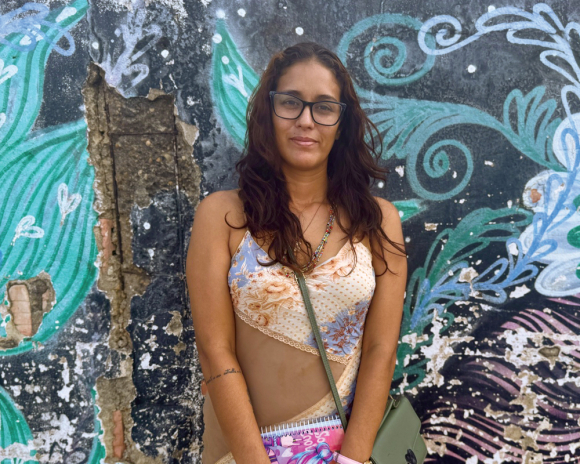
Alba Marina Gonzalez Andrade stands outside one of the informal migrant settlements in Boa Vista. Julianna Deutscher
Former Venezuelan journalist Alba Marina Gonzalez Andrade points out the bustling migrant-owned businesses—this neighborhood in Roraima’s capital has become home to many Venezuelans. Now founder of Voz Migrante, a local migrant advocacy group, Gonzalez Andrade works to build a sense of community to prevent exploitation. From organizing community events to serving as a court interpreter, she has helped more than 1,000 Venezuelans since 2017.
Youth recruited into drug trafficking, families evicted by corrupt landlords, and skilled migrants falling into exploitative labor are just some of the forms of exploitation in northern Brazil. “Today they play with toy guns, and by tomorrow they’ll be selling drugs,” says Gonzalez Andrade, describing how criminal gangs corrupt migrant youth.
Many migrants arrive without a plan, she says, making them easy targets. “That’s what Voz Migrante aims to do: to empower individuals to take control of their own lives.” A paycheck and a roof aren’t enough to create lasting success, she says. Community resilience is key.
“They exploit you today, they traffic you. Today you suffer, today they beat you,” she says, “yet tomorrow you stand up and go work somewhere else.”
Bridging Borders: Mayra Figueiras
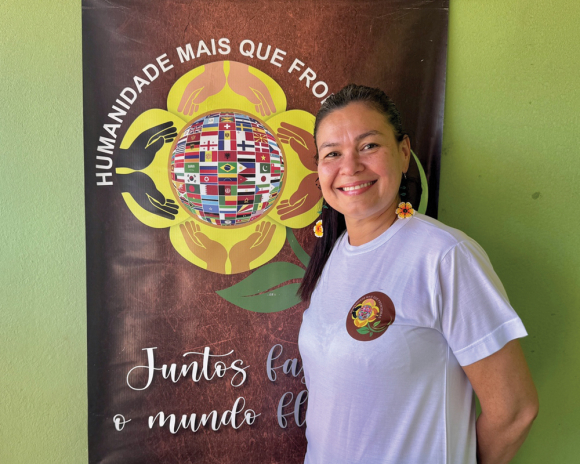
Mayra Figueiras poses with the logo she designed for her non-profit, Humanidade Mais que Fronteiras. Julianna Deutscher
Mayra Figueiras prevents human trafficking with vocational training, language classes, and—when possible—food baskets.
Figueiras, founder of Humanidade Mais que Fronteiras, also builds awareness by distributing calendars with emergency numbers for parents to call if their child goes missing, flip-flops embossed with a helpline number for youth, and cards with the national human rights reporting hotline.
In 2018, Figueiras realized that migrants wanting to learn Portuguese had to walk a long way at night to a university for evening lectures. This meant braving a host of safety issues, including getting hit by vehicles. So she searched for other options. “We managed to mobilize 92 Venezuelans, found three schools, and secured five teachers,” she says with a proud smile. She considers this the founding moment of her nonprofit.
To protect trafficking survivors, she collaborates with UN teams, the police, and human rights lawyers. She’s also created a peer support group of 40+ women who have experienced violence and human trafficking. They’ve helped each other rebuild their lives, and some have even been employed by UN agencies and NGOs.
The Leader: Selma Campos
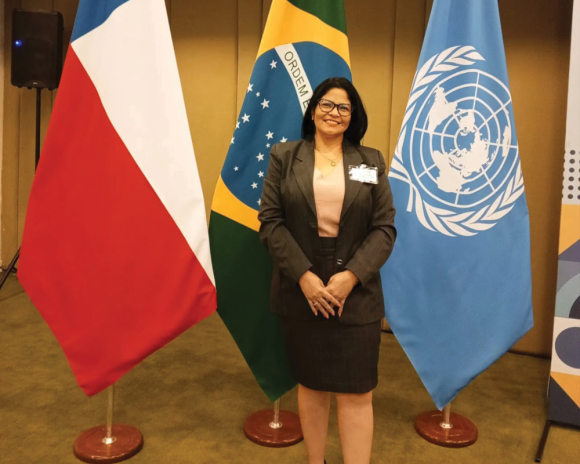
Selma Campos represented the migrant community living in Brazil at Cartagena +40 in 2024. Courtesy: Selma Campos
The 1984 Cartagena Declaration on Refugees marked a major shift in Latin America’s approach to forced displacement, broadening the definition of refugee to include those fleeing widespread human rights abuses.
Four decades later, Selma Campos, a Venezuelan who migrated to Brazil in 2009, served as an official representative of the migrant community living in Brazil at the Cartagena +40 Congress in 2024. Chosen for her leadership with the Panamerican and Caribbean Union for Human Rights, Campos highlighted the value of education and need for improved socioeconomic integration of migrants and refugees in their host communities.
“Education is vital in the lives of migrant children,” says Campos, noting that “schools are where we identify problems related to protection, sexual abuse, and exploitation.” President of AMARR, a rights-based organization that ensures migrant children have access to education, Campos has helped shape policies to ensure all children are welcome at school. Her organization works closely with UN agencies and NGOs to provide school registration workshops for families and to present at schools in Pacaraima about human trafficking.
In July, she learned that many of these partnerships may be unable to continue because of the loss of U.S. funding. Campos says she’s determined to find new collaborations to ensure that children continue to be equipped with knowledge to combat trafficking.
Leaving No One Behind: Marcia Maria de Oliveira
Research into human trafficking in Brazil’s north, one name consistently appears: Marcia Maria de Oliveira.
Professor and sociologist at the Universidade Federal de Roraima, Oliveira, PhD, has led human trafficking investigations for more than two decades.
A member of the Interdisciplinary Research Study Group on Borders (GEIFRON), Oliveira leads field work for a project on migration, violence, and human rights in Roraima state. Interviews with Venezuelan migrants revealed how criminal groups would groom women and children for sexual exploitation. Migrants talked about children kidnapped or sold for illegal adoption, slave labor, sex work, and even organ trafficking.
In a region where government and police surveillance of human trafficking has been greatly restricted due to resource limitations, Oliveira’s research is the best available data on trafficking in Roraima.
Her work, however, goes far beyond research alone. She actively helps connect survivors with vital support services and ensures that survivors are connected to authorities, so that thorough investigations can be made.
Oliveira teaches on the concept of “feminization of migration” and the need for migrant research to focus more on the impact of gender, particularly the role of gender-based violence. “Girls who have gone through migration find themselves in extremely vulnerable situations,” she says.
She emphasizes that current migration policies in Brazil do not protect women and children from human trafficking. While there was renewed momentum with the release of Brazil’s revised National Plan to Combat Human Trafficking in 2024, she notes that she has yet to see these recommendations be turned into action.
Bonfim’s Last Defense Against Trafficking: Sister Valdelice Gomes
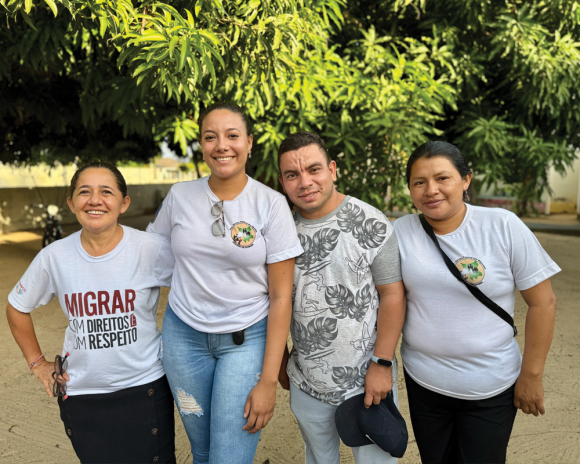
Sister Valdelice Gomes, far left, smiles with a group of volunteers in the churchyard in Bonfim. Julianna Deutscher
Sister Valdelice Gomes sits under a sketch of St. Josephine Bakhita, patron saint for victims of human trafficking. Accompanied by volunteers with the Pastoral dos Migrantes of the Diocese of Roraima, she shares the need for increased programs to assist migrants at the border with Guyana.
Unlike the border with Venezuela, here in Bonfim, there are no billboards welcoming migrants, no reception tents to assist with documentation, and no shelters.
Sister Gomes is the last defense against human trafficking for migrants passing through town on the way to Guyana. Each week she runs a workshop with the help of volunteers to assist migrants in applying for documentation and registering for government-funded social assistance programs. She also uses the opportunity to provide education on human trafficking. Her team of volunteers have encountered suspected trafficking cases and helped to connect these migrants to government-funded programs, police, and UN teams. It is, however, challenging because many of these resources are focused on Boa Vista, the region’s capital.
Sister Gomes hopes that more organizations will come to work in Bonfim. Until then, she dreams of opening a bakery, a community kitchen that can help distribute food. It’s one of the most common requests they receive: an ask for food.
A Life of Advocacy: Socorro Santos
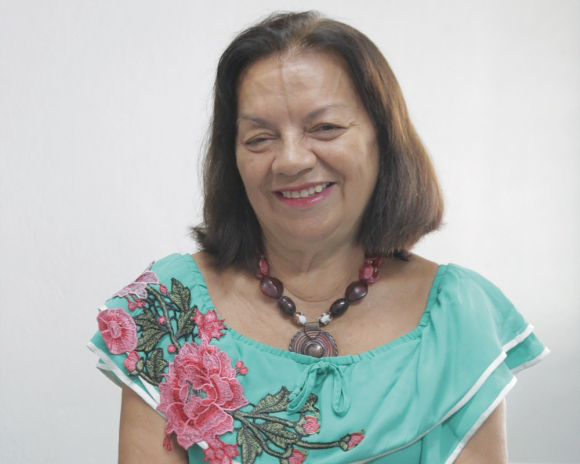
Socorro Santos has dedicated a lifelong career to fighting human trafficking. Courtesy: Socorro Santos
Socorro Santos has spent decades fighting trafficking. Santos, director of the Roraima Legislative Assembly’s Program for the Defense of Human Rights, helps shape state policies and supports survivors’ escape and recovery.
Her school-based program Educar e Prevenir (Educate and Prevent) trains students, teachers, and school custodial staff to spot signs of exploitation. After one workshop, a group of boys reported a teacher who was grooming a female classmate. Santos worked with authorities to ensure the girl received help, including psychological support. Since 2017, the program has reached more than 35 schools.
She also trains police to recognize trafficking, reminding them about the unique challenges faced by migrants. The sessions help to address xenophobia and provide cultural sensitivity training for interacting with the Venezuelan community.
The Crazy Nun: Sister Ana Maria da Silva
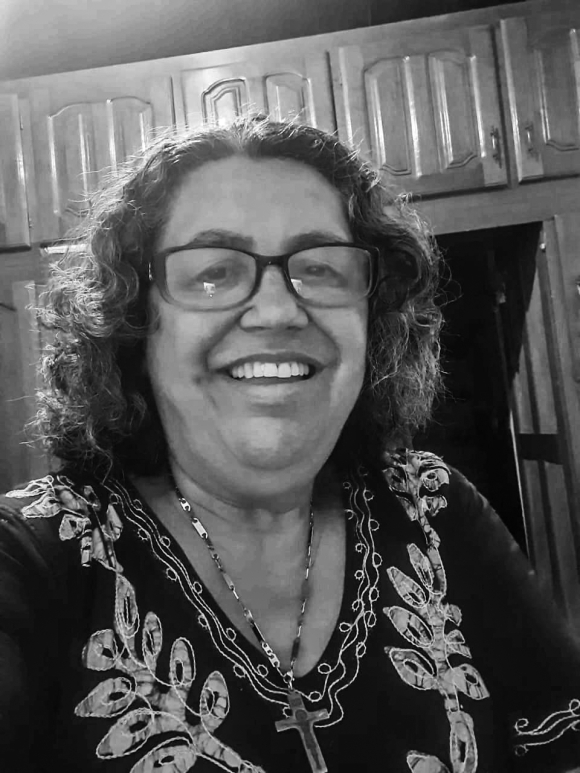
Sister Ana Maria da Silva, more commonly known as Madre Maria, shares a photo wearing the cross of her congregation—the Sisters of St. Joseph of Chambery. Courtesy: Sister Ana Maria da Silva
Whispers of La Monja Loca (The Crazy Nun) still linger in Pacaraima.
Sister Ana Maria da Silva earned the title during a police raid of her home in 2021. At the height of the pandemic, when borders were closed, migrants entered Brazil through trochas (informal border crossings). Undocumented, they slept on the streets. Sister da Silva opened her doors to single mothers and their children, sheltering them from sexual exploitation—the only means of survival for many.
She recalls having up to 120 people in her home, sleeping on pieces of cardboard. Her goal: goal was to protect as many as people as possible.
One early morning in 2021, police stormed the home. “They entered wearing hoods and carrying machine guns,” she says, “as if it were a place full of addicts and drugs.”
Sister da Silva threw herself in front of the officers demanding they show her a court order. “My adrenaline was pumping,” she says, animatedly re-enacting the encounter with the police, “I demanded their documents and questioned them so intensely that afterwards they were completely lost—they didn’t know what to do.”
Detained for questioning, she still managed to prevent the deportation of the women and children.
Her passion inspired ongoing support from the UN and NGOs, allowing her to move into a larger home now known as Casa de Acolhida de Sao Jose, a refuge that can host up to 200 women and children.
Today, she is more commonly known as Madre Maria (Mother Maria), member of the Sisters of St. Joseph of Chambery and a humanitarian who has dedicated 40 years to missionary work across Latin America and Africa.
Sister da Silva is currently in Europe, reconnecting with the roots of her congregation before she returns to Brazil at the end of August.
She challenges the global community to do better for migrants worldwide: “We … can’t just turn our backs and quietly stand by, arms crossed, watching all the suffering, can we?”
Julianna Deutscher, MD, MPH, is an emergency physician in Canada. In addition to her clinical work, she contributes to global health projects focusing on medical education, trauma program implementation, migrant and refugee health, and human trafficking prevention. Deutscher reported this article as a Johns Hopkins-Pulitzer Global Health Reporting fellow.
Join the 50,000+ subscribers in 170+ countries who rely on Global Health NOW summaries and exclusive articles for the latest public health news. Sign up for our free weekday newsletter, and please share the link with friends and colleagues.
Casa de Acolhida Sao Jose, founded by Sister Ana Maria da Silva, to help women and children migrants in Pacaraima, Brazil is a 15-minute walk from the Venezuelan border. Julianna Deutscher

